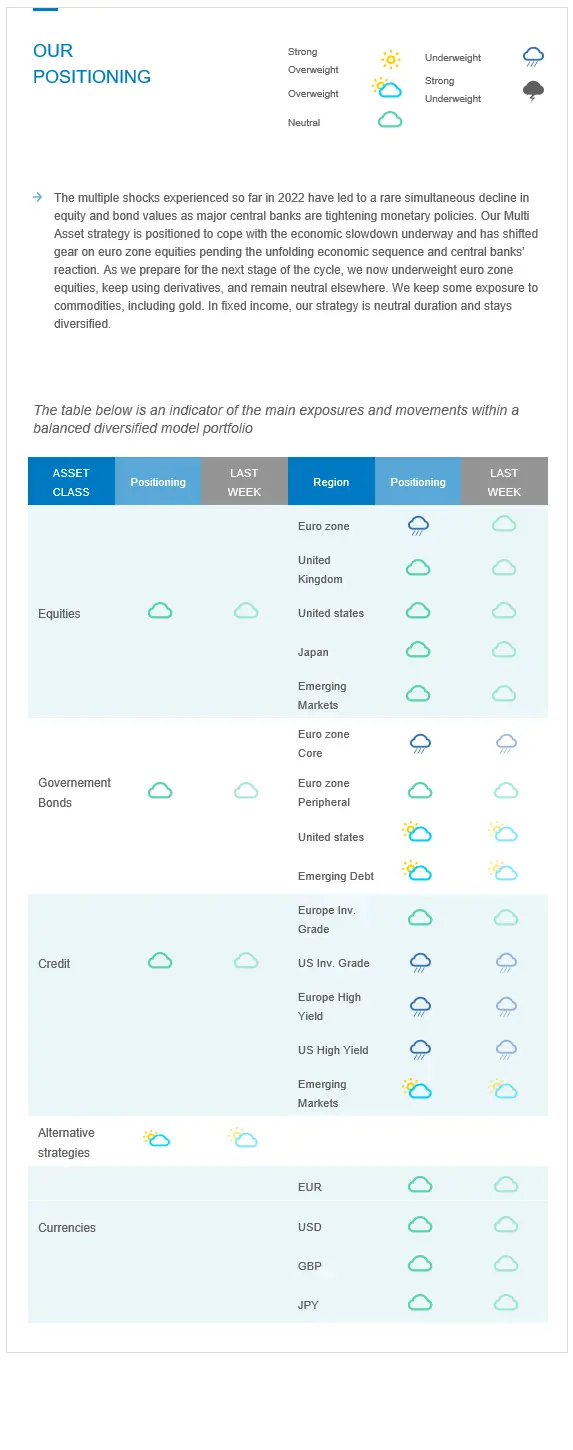Last week in a nutshell
- The euro went below parity with the US dollar for the first time in two decades. The pressure on the European Union currency is intensifying as the region faces an energy crisis following the invasion of Ukraine. Simultaneously, economic sentiment in the euro zone took a hit, showcasing the lowest reading since December 2011.
- Italian Prime Minister Mario Draghi’s resignation offer was rejected by President Sergio Mattarella. Mr. Draghi is now expected to face the parliament to keep his coalition together.
- US inflation surprised – again – on the upside and reached 9.1% in annual rate reading. Following the example of the Bank of Canada last week, a supersized 100bp Fed Funds rate hike is on the table for the end of this month, depending on incoming data.
- China’s GDP growth objective of 5.5% this year is in jeopardy as the country published a shrinking Q2 GDP vs Q1, missing forecasts. The large-scale lockdowns in Q2 hammered industrial activity and demand. For H2, the odds are in favour of the use of fiscal tools over additional interest rate cuts by the PBoC which has successfully kept inflation at relatively low levels.
What’s next?
- All eyes will be on the reopening (or not) following the shutdown of the Nord Stream pipeline for a scheduled 10-day maintenance period. The gas pipeline connects Russia to Germany and supplies most of the European Union. The EU is looking into alternatives but may need to brace itself for a winter of limited - and expensive - gas supply.
- The European Central Bank is due to announce its first interest rate hike since 2011. The subsequent press conference is expected to reveal details on the tool tackling financial fragmentation in the region. Elsewhere, central banks in Japan, Indonesia, Turkey and South Africa are also making interest rate decisions.
- Flash PMI for services and manufacturing activity will be published giving investors clues to gauge the depth and momentum of the slowdown in the economic cycle.
- In the US, several housing data will allow to gauge the activity in this vital sector as rising mortgage rates and rising building material costs have hit the affordability of buyers: the NAHB housing market index, Housing starts, building permits and existing home sales will be scrutinised.
Investment convictions
Core scenario
- Our exposure keeps an overall broadly balanced allocation.
- While the market environment still appears constrained by deteriorating fundamentals, markets are looking forward to the upcoming central bank announcements in July.
- Facing multi-decade high inflation, the Fed started its hiking cycle in March and plans to add further giant steps to its funds rate by end-July and continue tightening thereafter. In our best-case scenario, the Fed succeeds in landing the economy. As a result, we expect the rise in the US 10Y yields to fade.
- Inflation is also at highs in the euro zone, hitting businesses, consumers, and ECB policymakers alike. The ECB pre-announced an initial rate hike for the month of July. Investors expect the announcement of new tools to address the risk of financial fragmentation.
- Facing high inflation, central bank policy tools have triggered a sharp tightening in financial conditions while the global economic slowdown is now well underway. The war in Ukraine and the slowing global weigh on confidence. The economic activity in China slowed down considerably in April and May but should pick up during H2 as stimulus measures kick-in.
- The reasons for a balanced allocation have been called into question by the decline in Russian gas flow, even ahead of the shutdown of the Nord Stream pipeline. The European Union is especially vulnerable to the tug of war with Russia. The risks we previously outlined are starting to materialize and are now part of the scenario.
Risks
- Investor concerns are shifting from inflation concerns to growth concerns.
- The war in Ukraine is pushing upwards gas prices. European activity is at the mercy of flows staying open.
- A brutal, faster-than-anticipated rate tightening - if inflationary pressures increase via a new energy shock or simply persist at current levels- could jeopardize any soft landing.
- Other countries may face the Bank of England (BoE) stagflation dilemma: Even as the growth outlook deteriorates sharply, signs of upward pressure on inflation expectations, near-term wage and price setting behaviours remain.
- The threat of COVID-19 and its variants remain as the virus keeps evolving and spreading further.
Recent actions in the asset allocation strategy
The multiple shocks experienced so far in 2022 have led to a rare simultaneous decline in equity and bond values as major central banks are tightening monetary policies. Our Multi Asset strategy is positioned to cope with the economic slowdown underway and has shifted gear on euro zone equities pending the unfolding economic sequence and central banks’ reaction. As we prepare for the next stage of the cycle, we now underweight euro zone equities, keep using derivatives, and remain neutral elsewhere. We keep some exposure to commodities, including gold. In fixed income, our strategy is neutral duration and stays diversified.
Cross asset strategy
- Our multi-asset strategy stays more tactical than usual and can be adapted quickly in this highly volatile context:
- Underweight euro zone equities, with a derivative strategy in place to catch the asymmetric potential. We have a preference for the Consumer Staples sector.
- Neutral UK equities, resilient segments, and global exposure
- Neutral US equities, with an actively-managed derivative strategy, as we remain attentive to the Fed’s forward guidance.
- Neutral Emerging markets, because our assessment indicates an improvement, especially in China, both on the COVID-19 / lockdown and stimulus fronts during H2.
- Neutral Japanese equities, as accommodative central bank, and cyclical sector exposure act as opposite forces for investor attractiveness.
- With some exposure to commodities, including gold.
- In terms of sectors, we now favour the “long duration” assets, i.e. tech names, as we expect less headwinds from bond yields during H2.
- In the fixed income universe, we acknowledge downward revisions in growth, highs in inflation expectations and strong central bank rhetoric regarding the willingness to tighten and fight inflation. We are neutral duration, with a preference for US duration.
- We continue to diversify and source the carry via emerging debt.
- In our long-term thematics and trends allocation: While keeping a wide spectrum of long-term convictions, we will favour Climate Action (linked to the energy shift) and keep Health Care, Tech and Innovation, Demographic Evolution and Consumption.
- In our currency strategy, we are positive on commodity currencies:
- We are long CAD.

